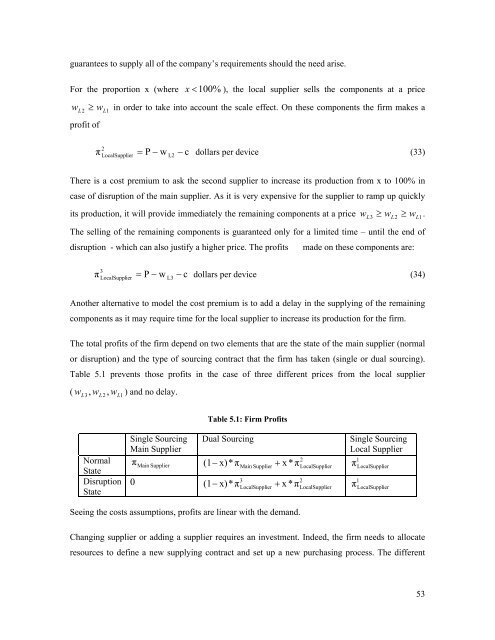Managing Risks of Supply-Chain Disruptions: Dual ... - CiteSeerX
Managing Risks of Supply-Chain Disruptions: Dual ... - CiteSeerX
Managing Risks of Supply-Chain Disruptions: Dual ... - CiteSeerX
Create successful ePaper yourself
Turn your PDF publications into a flip-book with our unique Google optimized e-Paper software.
guarantees to supply all <strong>of</strong> the company’s requirements should the need arise.For the proportion x (where x < 100%L2 L1), the local supplier sells the components at a pricew ≥ w in order to take into account the scale effect. On these components the firm makes apr<strong>of</strong>it <strong>of</strong>π2LocalSupplier= P − w − c dollars per device (33)L2There is a cost premium to ask the second supplier to increase its production from x to 100% incase <strong>of</strong> disruption <strong>of</strong> the main supplier. As it is very expensive for the supplier to ramp up quicklyits production, it will provide immediately the remaining components at a price wL3 ≥ wL2≥ wL1.The selling <strong>of</strong> the remaining components is guaranteed only for a limited time – until the end <strong>of</strong>disruption - which can also justify a higher price. The pr<strong>of</strong>its made on these components are:π3LocalSupplier= P − w − c dollars per device (34)L3Another alternative to model the cost premium is to add a delay in the supplying <strong>of</strong> the remainingcomponents as it may require time for the local supplier to increase its production for the firm.The total pr<strong>of</strong>its <strong>of</strong> the firm depend on two elements that are the state <strong>of</strong> the main supplier (normalor disruption) and the type <strong>of</strong> sourcing contract that the firm has taken (single or dual sourcing).Table 5.1 prevents those pr<strong>of</strong>its in the case <strong>of</strong> three different prices from the local supplier( wL3 , wL2, wL1) and no delay.Table 5.1: Firm Pr<strong>of</strong>itsNormalStateDisruptionStateSingle Sourcing <strong>Dual</strong> SourcingMain Supplierπ (1−x)* π x * πMain SupplierMain Supplier+03(1−x)* π x * πLocalSuppl ier+2LocalSupplier2LocalSupplierSingle SourcingLocal Supplier1πLocalSupplier1πLocalSupplierSeeing the costs assumptions, pr<strong>of</strong>its are linear with the demand.Changing supplier or adding a supplier requires an investment. Indeed, the firm needs to allocateresources to define a new supplying contract and set up a new purchasing process. The different53
















